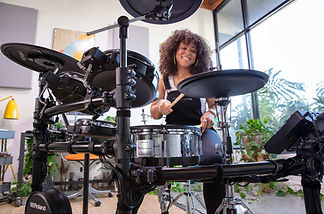LEARNING
Getting your drum on…practice makes perfect!
I'm a paragraph. Click here to add your own text and edit me. I’m a great place for you to tell a story and let your users know a little more about you.
I'm a paragraph. Click here to add your own text and edit me. I’m a great place for you to tell a story and let your users know a little more about you.
-
A good size drum stick to start with is either size 5A or 5B. Choose a good quality stick like pro-mark, or Vic Firth – they have good balance, are finished well and are made from good quality wood that some of the lesser brands do not use – plus they’ll last longer! You can also make sure the sticks are fairly straight by rolling them on a counter top. If the sticks are warped, they will naturally turn in your hand as you play and not give you a good “feel” or sound when playing on a drum head.

Drum Sticks
Metronome
-
It’s a good idea to either have an electronic metronome, or load a metronome app on your phone to practice with. Staying in-time is the most important element in learning and playing drums…especially when you’re playing with a band, orchestra or group!
I'm a paragraph. Click here to add your own text and edit me. I’m a great place for you to tell a story and let your users know a little more about you.


-
For learning rudiments, it is advisable to purchase a practice pad – essentially a rubber pad affixed to a wood-like disc. This will keep the sound at a minimum so you can concentrate on practicing to a metronome. There are many versions available: Vic Firth makes an excellent 2-sided pad, and the Evans “Real-Feel” pad is also nice with a natural rebound.
Practice Pad
Posture
Playing at your drum set should feel relaxed and natural. Ergonomically speaking it’s best to have your drums set up so you don’t have to reach too far to play. Cymbals should be set low and drums easily reachable from a good-posture (straight back) sitting position.


Drum Mutes
-
To keep the sound level down while playing in your house or apartment, drum mutes can be placed on your drum heads and cymbals. Essentially, they are giant rubber “mouse pads” that fit onto the drum rims to deaden the sound. They don’t give you the real feel or sound of playing a set, but they can help preserve the sanity of family, roommates or neighbors. Vic Firth and Sound Percussion as well as others have full set packs available for all size drums.
Drum Sets
-
In the “good old days”, kids drum sets or “junior” sets weren’t available – you had to learn on a standard, adult kit. These days, there are many options available for kids from pre-school age and up. The choices can become daunting as the quality of the instruments on the market vary greatly. Here, the adage “you get what you pay for” comes into play, but do you really want to shell out significant bucks for a drum set that may languish in the corner unused and unloved a few months later? Fear not, there are several viable options.
-
A great web site for reviews of junior drum sets is www.kickstartyourdrumming.com. Generally speaking, a “junior set” will work for a child up to 5’ tall. There are some sets available that have a nice combination of “build quality” and price point where you can find a nice instrument that will motivate the novice to play, but not break the bank. These junior sets usually include all you need to start banging away; drums, pedals, cymbals and stands. As your young drummer advances and shows a real interest in pursuing the art, there are other options available.
-
Many aspiring drummers are turning to electronic drums sets instead of acoustic kits because of sound restrictions in their practicing environments. Electronic kites have come a long way from the hard rubber pads that dominated the market. Manufacturers are trying to approximate the feel of acoustic drums by using synthetic mesh drum heads which have a "give" when struck. Technology in these kits has grown exponentially year by year with a typical beginner kit having 30 to 40 different drum sets stored in the their modules. These electronic kits can be played with headphones, thereby reducing noise levels in apartments, condos and houses.



Lesson Resourses
There are so many great resources for learning beginning to advanced drums, from books to audio to YouTube lessons online.
We will explore different publications, from basic reading of drum notation and working on fun a challenging exercises to incorporating "drum charts" that transcribe the notation of particular songs so you can play your favorite tunes, and understand the song structure on drums.



